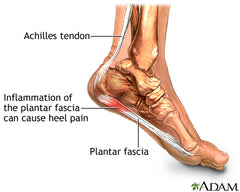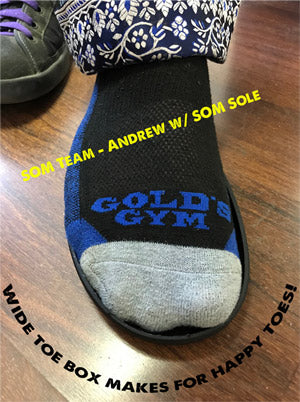In this blog, we are hoping to shed some light on how plantar fasciitis and foot pain can be affected by your shoes. Specifically, we’d like to investigate if wide-toe-box, zero-drop shoes can help plantar fasciitis. What is plantar fascia, (what is a fascia and what is it planting, anyway?!), and how does your footwear affect it? Read on to find out!
(**Disclaimer: While we at SOM have a PHD (Positive Happy Dedication) in Sneakerology, we are not podiatrists or physical therapists! We present helpful and insightful information, but as with anything, your mileage may vary!)
What is plantar fascia?
Your plantar fascia is a piece of connective tissue that connects the heel of your foot with your toes. It is the primary supportive structure for the arch of your foot and is under constant stress by design! Small rips or tears can occur when you add extra strain to a muscle already under continuous tension. Commonly described as a burning or stabbing pain, which is more common first thing in the morning or after long periods of sitting, plantar fasciitis is one of the leading causes of heel pain in the United States.

Do we know the cause of plantar fascitis?
Plantar fasciitis can affect anyone, and specific activities can cause the muscle to become irritated; these include occupations that keep you on your feet, exercising, having flat feet or higher-than-average arches, or being overweight, etc. The pain is due to a lack of consistent blood flow to the plantar fascia by the tibialis posterior artery. ( Source here.) The good news is that, according to many sources, plantar fasciitis can be helped or prevented with proper footwear.

There is some conjecture about what occurs when someone experiences plantar fasciitis. This condition has been treated as an inflammation for decades, and therapies have been based reducing inflammation and pain (NSAID medication for pain and icing the affected foot). Research in the past two decades has caused some doctors to reclassify the condition as a degenerative or necrotic process, where the muscles and ligaments are not just in pain; they are dying due to lack of blood flow. The unfortunate truth is that overbuilt shoes with thick soles and too much padding make your feet and leg muscles weaker (think: lazy), change the biomechanics of your gait and can lead to injuries. While there is lots of discussion still to be had about the barefoot lifestyle, one thing is for sure you were not born with shoes on your feet!

Podiatrist Recommended
Dr. Ray McClannahan, internationally known podiatrist and funder of Correct Toes device (www.correcttoes.com) postulates that standard footwear, with a raised heel, tapered toe-box, and “toe spring” (where the toe of the shoe curves up) hold the foot in a position that restricts blood flow and increases stress on the muscles on the bottom of the foot, which can lead to plantar fasciitis. Conversely, a wide-toe-box, zero-drop shoe with a flexible sole can help strengthen feet and allow them to function naturally, as intended.

Can zero-drop shoes fix plantar fascitis?
If you are experiencing plantar fasciitis pain, thinking that barefoot-inspired shoes will “fix” the problem may not be the case! (Source here.)
Natural foot-shape, zero-drop shoes, like SOM Footwear, are integral to your healing process. Allowing feet to be in their natural position will help cure many patients. The foot conditions will determine what else to do to rehabilitate some feet. For example, some people will see their pain increase when barefoot, indicating that their feet have been de-conditioned to their natural state. Along with being in natural footwear, they will need a rehab program to see some improvement.
While preparing this blog, some of the articles we reviewed recommended the opposite: support the arch, cushion the sole and heel as much as possible, invest in supportive orthotics, etc. The underlying concept most of these articles and doctors came back to, however, was that once the pain subsides, you need to do something about the underlying CAUSE of the pain, or else you will be treating the EFFECTS forever!
Of course, an ounce of prevention is worth a pound of cure, so if you are worried about foot pain, making a move to minimalist shoes can help strengthen your feet and calves, let your toes stretch out and have room to play, and put you back in touch with your original Sense of Motion that you were born with: all of this is possible in a barefoot-style, wide-toe-box, zero-drop, minimalist shoe!

In closing, while we are not doctors, we are SUPER passionate about helping people increase the quality of their lives from the toes up! We follow one principle: common sense. If we can help anyone find relief from foot pain with barefoot style shoes or help educate people about the foot health benefits of wide-toe-box, zero-drop, minimalist footwear, then we will go home happy! Thank you for reading about the correlation between wide-toe-box , zero-drop, minimalist shoes and plantar fasciitis. We hope you learned something! So long for now!

Same here, I’ve tried almost every shoe, all are restrictive at the midfoot, even if they’re labelled wide fit. I have rigid arches that won’t supinate, but have been told by some that I overpronate, so they gave me orthotics which exacerbated the problem, it’s a nightmare.
Donna,
Thank you for your comment. We understand the confusion. If you want to receive honest information from a genuine doctor, we recommend Dr. Ray McCanahan. His website has so much information, and according to our customers, he has helped them recover from all kind of issues. The link to his website resource articles is: https://www.nwfootankle.com/patient-resources/#pr-articles-studies. Best of luck!
It’s so confusing. Everything else I’ve read, and been told by podiatrist and osteopath, points to wearing my orthotics (to stop pronation) inside a stable, neutrally balanced shoe, with a bit of a heel. I am going around in circles trying to find THE shoe – given I don’t have the funds to purchase endless ‘mistake’ shoes.